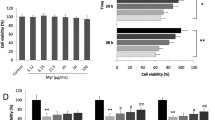We aimed to investigate the underlying function and mechanism of E1231 against diabetic cardiomyopathy (DCM). H9c2 cells were exposed to either 33 mmol/L mannitol or an identical concentration of glucose (high glucose, HG) in vitro. In vivo, diabetes mellitus (DM) mice were induced by injection of 60 mg/kg streptozotocin intraperitoneally. E1231 was used to treat cells (5 mmol/L) or animals (40 mg/kg), and subsequent assays were conducted to determine its effect on DCM-associated manifestations. Western blot was employed to evaluate protein expressions of the silent information regulator 1 (SIRT1), peroxisome proliferator-activated receptor-γ coactivator-1α (PGC-1α), and nuclear factor erythroid 2-related factor 2 (Nrf2). In vitro, treatment with E1231 significantly reduced oxidative stress and apoptosis induced by HG via activating the SIRT1-PGC-1α/Nrf2 pathway in H9c2 cells, compared to cardiomyocytes under HG conditions. In vivo, DM mice showed up-regulated SIRT1, PGC-1α, and Nrf2 expression, with protection against cardiac fibrosis, dysfunction, and oxidative stress impairment. The study demonstrated that E1231 alleviates cardiac dysfunction via activating the SIRT1-PGC-1α signaling pathway in DCM, leading to the activation of Nrf2. Therefore, E1231 has the potential to facilitate the treatment of DCM.




Similar content being viewed by others
References
L. Guariguata, D. R. Whiting, I. Hambleton, et al., Diabetes Res. Clin. Pract., 103(2), 137 – 149 (2014).
J. B. Cole and J. C. Florez, Nat. Rev. Nephrol., 16(7), 377 – 390 (2020).
W. H. Dillmann, Circ. Res., 124(8), 1160 – 1162 (2019).
E. Jordan and R. E. Hershberger, Heart, 107(2), 106 – 112 (2021).
R. H. Ritchie and E. D. Abel, Circ. Res., 126(11), 1501 – 1525 (2020).
L. Yin, Y. Fang, T. Song, et al., J. Cell. Mol. Med., 23(4), 2558 – 2567 (2019).
W. Ding, H. Feng, W. J. Li, et al., Eur. J. Pharmacol., 909, 174402 (2021).
R. Romero-Becerra, A. M. Santamans, C. Folgueira, et al., Int. J. Mol. Sci., 21(19), 7412 (2020).
S. M. Khadrawy and R. A. El Sayed, J. Biochem. Mol. Toxicol., 37(4), e23296 (2023).
N. Kaludercic and F. Di Lisa, Front. Cardiovasc. Med., 7, 12 (2020).
B. Parim, V. V. Sathibabu Uddandrao and G. Saravanan, Heart Fail. Rev., 24(2), 279 – 299 (2019).
Y. Bi, Y. Zhang and J. Ren, Am. J. Physiol. Heart Circ. Physiol., 318(5), H1029-h1031 (2020).
P. Zhabyeyev, B. McLean, X. Chen, et al., J. Mol. Cell. Cardiol., 132, 98 – 109 (2019).
H. Li, Y. Shi, X.Wang, et al., Chem. Biol. Interact., 310, 108754 (2019).
Z. D. Ge, Q. Lian, X. Mao, et al., Int. Heart J., 60(3), 512 – 520 (2019).
K. Li, L. Gao, S. Zhou, et al., Mol. Cell. Biochem., 478(3), 651 – 663 (2023).
H. Liu, S. Zhu, W. Han, et al., Ecotoxicol. Environ. Saf., 221, 112449 (2021).
S. Ma, J. Feng, R. Zhang, et al., Oxid. Med. Cell. Longev., 2017, 4602715 (2017).
B. Han, S. Li, Y. Lv, et al., Food Funct., 10(9), 5555 – 5565 (2019).
Y. Xu, W. Tu, D. Sun, et al., Biochem. Biophys. Res. Commun., 554, 49 – 55 (2021).
S. **e, X. Jiang, D. M. Doycheva, et al., J. Neuroinflammation, 18(1), 226 (2021).
K. Peng, F. Yang, C. Qiu, et al., Clin. Exp. Pharmacol. Physiol., 50(3), 218 – 227 (2023).
T. Feng, P. Liu, X. Wang, et al., Atherosclerosis, 274, 172 – 181 (2018).
C. Y. Tsai, S. Y. Wen, S. Y. Cheng, et al., J. Cell. Biochem., 118(7), 1659 – 1669 (2017).
Y. Sun, K. Zhou, M. He, et al., J. Fluorescence, 30(6), 1421 – 1430 (2020).
N. Atale, M. Chakraborty, S. Mohanty, et al., Cardiovasc. Toxicol., 13(3), 278 – 289 (2013).
J. Zeng, D. Li, Z. Li, et al., Biol. Pharm. Bull., 43(5), 864 – 872 (2020).
Y. Tan, Z. Zhang, C. Zheng, et al., Nat. Rev. Cardiol., 17(9), 585 – 607 (2020).
X. Palomer, D. Aguilar-Recarte, R. García, et al., Trends Mol. Med., 27(6), 554 – 571 (2021).
F. Husen, H. Hernayanti, N. Ekowati, et al., Int. J. Med. Mushrooms, 23(10), 9 – 21 (2021).
P. M. Seferoviæ and W. J. Paulus, Eur. Heart J., 36(27), 1718 – 27, 1727a-1727c (2015).
E. Liang, X. Liu, Z. Du, et al., Oxid. Med. Cell. Longev., 2018, 9086747 (2018).
B. Zhang, M. Zhai, B. Li, et al., Oxid. Med. Cell. Longev., 2018, 3159801 (2018).
S. Winnik, J. Auwerx, D. A. Sinclair, et al., Eur. Heart J., 36(48), 3404 – 3412 (2015).
M. Tan, C. Peng, K. A. Anderson, et al., Cell Metab., 19(4), 605 – 617 (2014).
X. Palomer, J. Pizarro-Delgado and M. Vázquez-Carrera, Trends Pharmacol. Sci., 39(5), 452 – 467 (2018).
M. A. Potenza, L. Sgarra, C. Nacci, et al., PLoS One, 14(1), e0210654 (2019).
A. I. Krämer and C. Handschin, Int. J. Mol. Sci., 20(21), 5449 (2019).
T. Zhang, Y. Chi, Y. Kang, et al., J. Cell. Physiol., 234(4), 5033 – 5043 (2019).
H. Wang, T. O. Khor, Q. Yang, et al., Mol. Pharm., 9(10), 2819 – 2827 (2012).
Z. Wang, S. Yuan, Y. Li, et al., Biochem. Pharmacol., 150, 54 – 63 (2018).
Author information
Authors and Affiliations
Corresponding author
Additional information
Yunxia Cui and Hongjun Lou are co-first authors.
Rights and permissions
Springer Nature or its licensor (e.g. a society or other partner) holds exclusive rights to this article under a publishing agreement with the author(s) or other rightsholder(s); author self-archiving of the accepted manuscript version of this article is solely governed by the terms of such publishing agreement and applicable law.
About this article
Cite this article
Cui, Y., Lou, H., Guo, Q. et al. E1231 Alleviates Diabetic Cardiomyopathy by Regulating the Silent Information Regulator 1/Peroxisome Proliferator-Activated Receptor-γ Coactivator-1α/Nuclear Factor Erythroid 2-Related Factor 2 Pathway. Pharm Chem J 58, 227–237 (2024). https://doi.org/10.1007/s11094-024-03138-6
Received:
Published:
Issue Date:
DOI: https://doi.org/10.1007/s11094-024-03138-6




